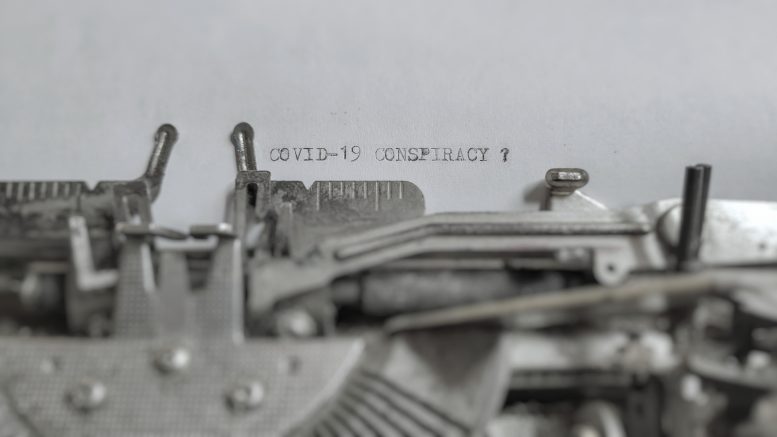By Nathanial Doromal
How do you counter news media claims of conspiracy theories?
PART 2: Six Questions to Help Assess Claims of Conspiracy Theory
News media claims of a ‘conspiracy theory’ come with an embedded message: “we are the authorities, and we have done the thinking for you, sostop thinking about this.” As a counter tactic, one must apply critical thinking, and the following framework can help. Ask yourself these questions:
- Are there any uses of logical fallacies or rhetorical devices present in defending the “official narrative”?
Critical to assessing credibility is an awareness of logical fallacies and rhetorical devices used to influence your beliefs:
- Ad hominem arguments: attacks on the character, motives, or attributes of the person or group bearing a message without attacking the substance of the logical argument. Ad hominem attacks are often made with pejorative labels: racist, anti-vaxxer, anti-science, Communist, etc.
- Red herring/deflection: introduction of tangential information to deliberately mislead or distract from the core question at hand.
- Strawman: distortion of the opposing party’s actual positions to give the impression of refuting or defeating that position.
- Non-sequitur: from the Latin phrase “it does not follow,” this fallacy involves stating a series of facts and then deriving a conclusion that does not follow those facts.
- Cherry-picking: bringing up data or cases which support a particular position while ignoring significant data that contradicts the position.
- Begging the question: use of circular reasoning; a presumption that the conclusion is true, instead of providing the necessary support for it.
- Appeal to authority: claiming the truth of a premise by citing the testimony of an authority figure instead of presenting actual evidence for it.
- Lie by omission: lying by either omitting certain facts or by failing to correct a misconception.
- What are the assertions made in the article that the author assumes “every reasonable person must believe”?
Disentangling the half-truths and assumptions in the overall message is critical to understanding the core of propaganda that weaponizes conspiracy theory. The author’s assumptions about what everyone should believe are also important. For example, “any reasonable person must vaccinate” or “any reasonable person must listen to his or her doctor.”
Both are examples that serve to influence your beliefs through the begging the question fallacy: if you do the prescribed actions, then you are “reasonable”; otherwise, you are not reasonable. This is the ad hominem fallacy: sending the implicit message that anyone who fails to take the given action is unreasonable.
- Who benefits from the official narrative?
The official narrative is the one that predominates in the mainstream discourse; the narrative is propagated by both government officials and the mainstream media. Identification of power holders and/or establishment interests and imagining how they might benefit from the official narrative is important. For example, the defense industry benefits from the sale of munitions, therefore the industry has an incentive to lobby for continued investment in military technology.
- How accurate is the portrayal of the alternative narrative, and whose interests are harmed by it?
First, we must identify how accurate the portrayal of the alternative narrative really is. Sometimes, the alternative narrative is deliberately presented as a strawman to make the dominant narrative appear more favorable. For example, blaming COVID-19 deaths on 5G technology is a strawman that attempts to hide legitimate concerns regarding 5G behind a more questionable charge.
There is also another variant to the strawman argument. Quite often, there are several alternative narratives, and the most extreme or implausible narrative is chosen and focused upon. We will later examine a piece on the COVID-19 vaccine that utilizes this pattern.
Second, an important question to ask is: whose interests are harmed by the alternative narratives and to what extent? When the harms caused by smoking were becoming more widely known, the tobacco companies had numerous financial incentives to deny or downplay these concerns. Similarly, current health concerns about wireless technology hurt the technology providers of such equipment and the overall growth of the wireless global market.
Useful questions to consider are:
- How much money is to be made in the market by dominant players?
- Does the alternative narrative damage existing revenue streams for these players?
- Does the alternative narrative change the environment in a way that would hurt the existing players?
- Does the alternative narrative damage the ability of the existing players to influence society?
- How credible is the alternative narrative?
One must judge the alternative narrative’s credibility by examining the actual arguments used to support its position. Weaponized pieces work by convincing people that the probability of the alternative narrative is so low as to not be reasonable. It helps to question the assumptions made by the piece and to clarify the limits of such assumptions.
- How much questioning is permitted? How much intimidation is used against individuals who object to the official narrative?
Biased propaganda pieces can be distinguished by the level of vitriol aimed at individuals who object to the official narrative. Does the piece allow the reader to make his or her own judgment? Or does it intimidate the reader into accepting the author’s views?
++++++++++++++++++++++++++++++++
 Like what you’re reading on Vaxxter.com?
Like what you’re reading on Vaxxter.com?
Share this article with your friends. Help us grow.
Join our list here
++++++++++++++++++++++++++++++++
Nate Doromal is an activist and writer within the Vaccine Awareness and Vaccine Safety movement. He is a veteran software engineer, formerly with Google. Doromal now works in finance. He holds an MS and an MBA in Computer Science from the University of Chicago. He holds an Executive MBA from the Smartly Institute. He was originally trained on vaccines and vaccine activism by Dr. Sherri Tenpenny in her Mastering Vaccine Info Bootcamp. He has also studied immunological science extensively with Dr. Tetyana Obukhanych through her Building Bridges Course. He is a contributing writer for Children’s Health Defense.

